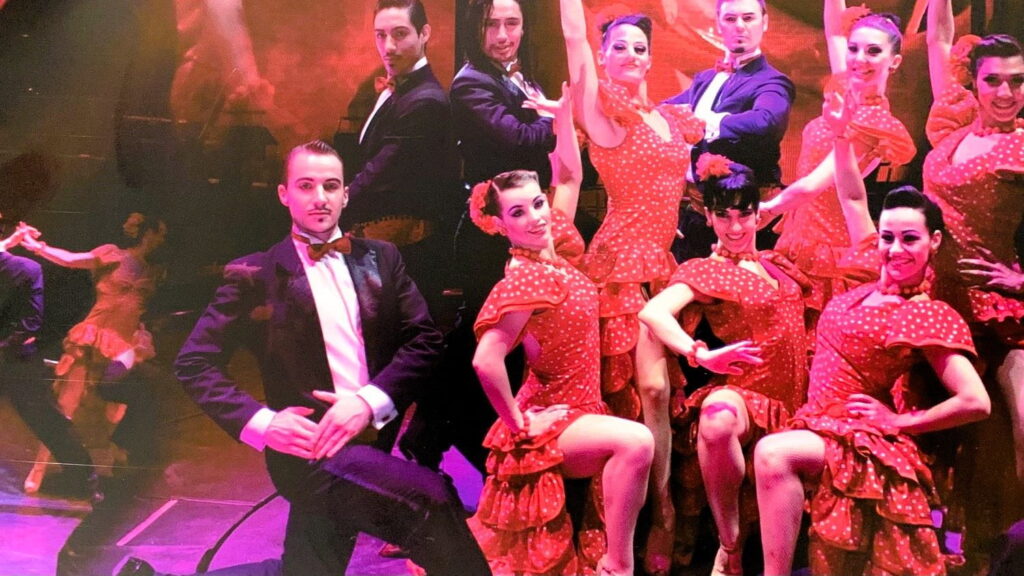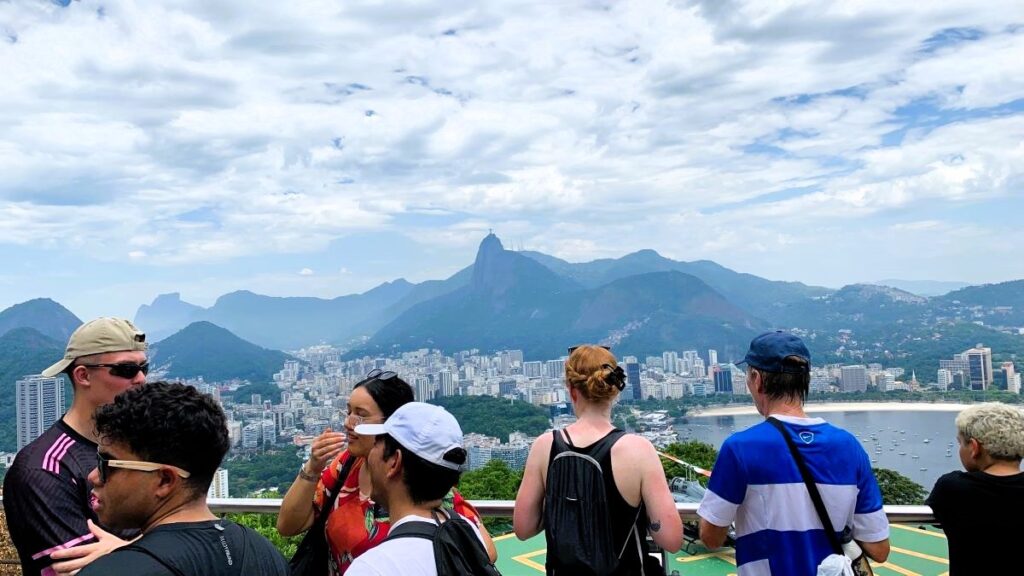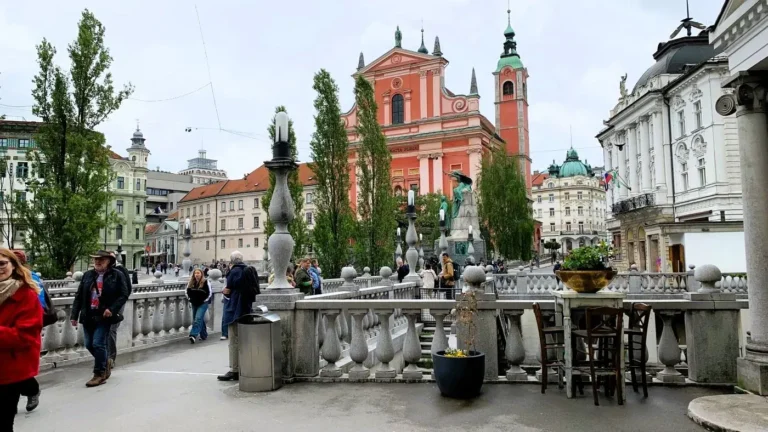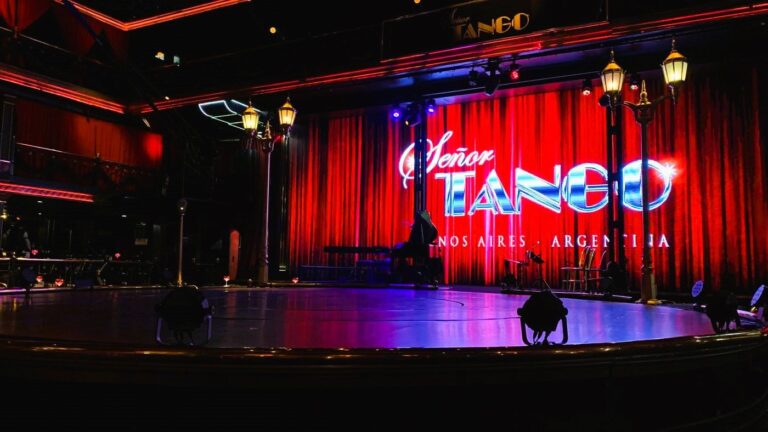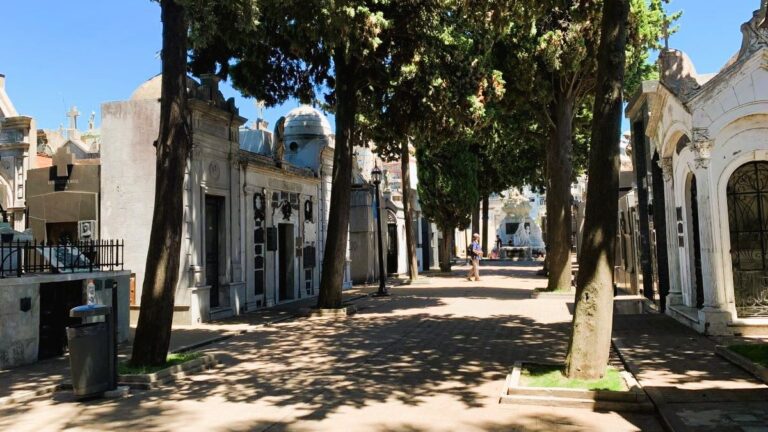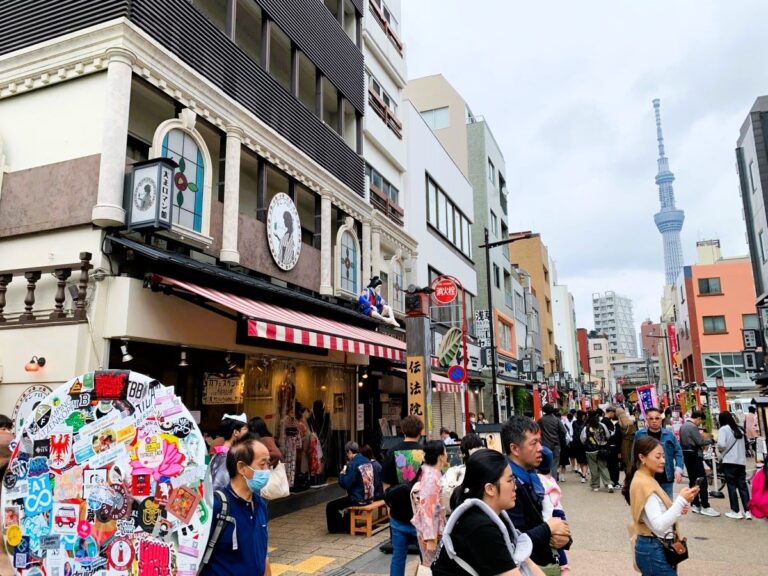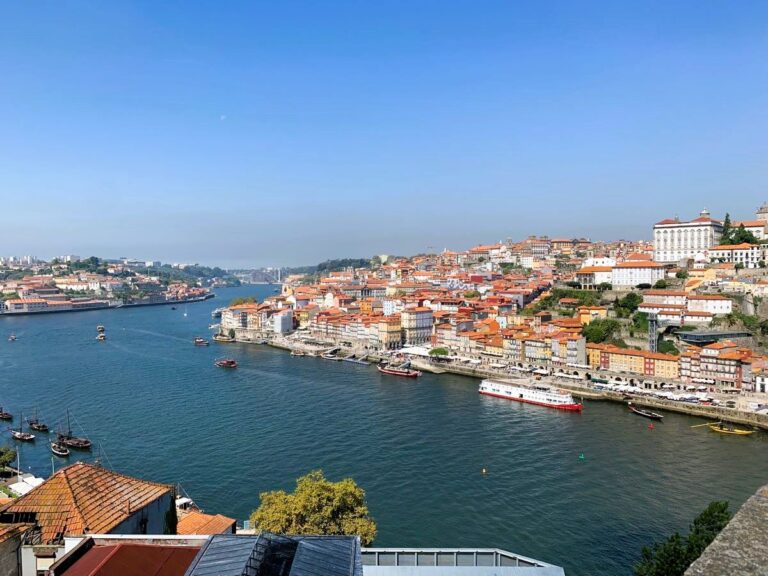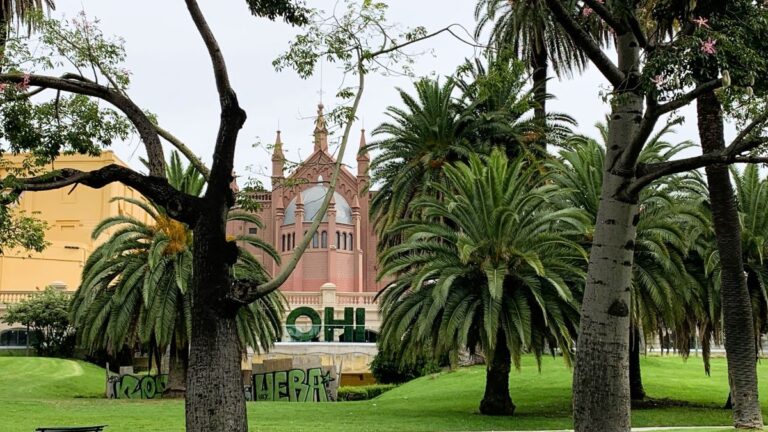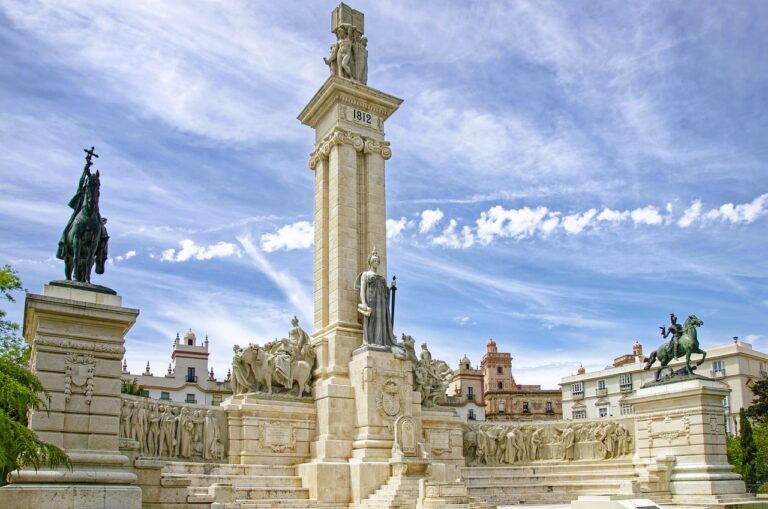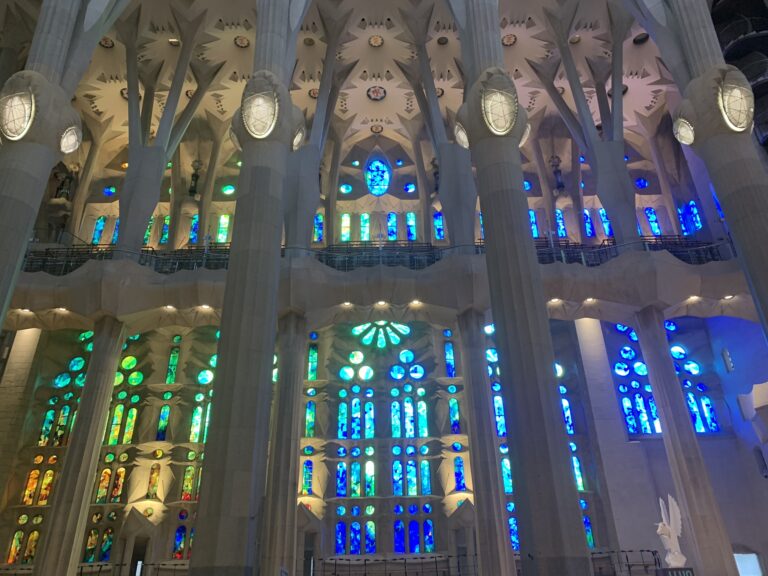20 Best Things to Do in Buenos Aires for First-Time Visitors [2025 Guide]
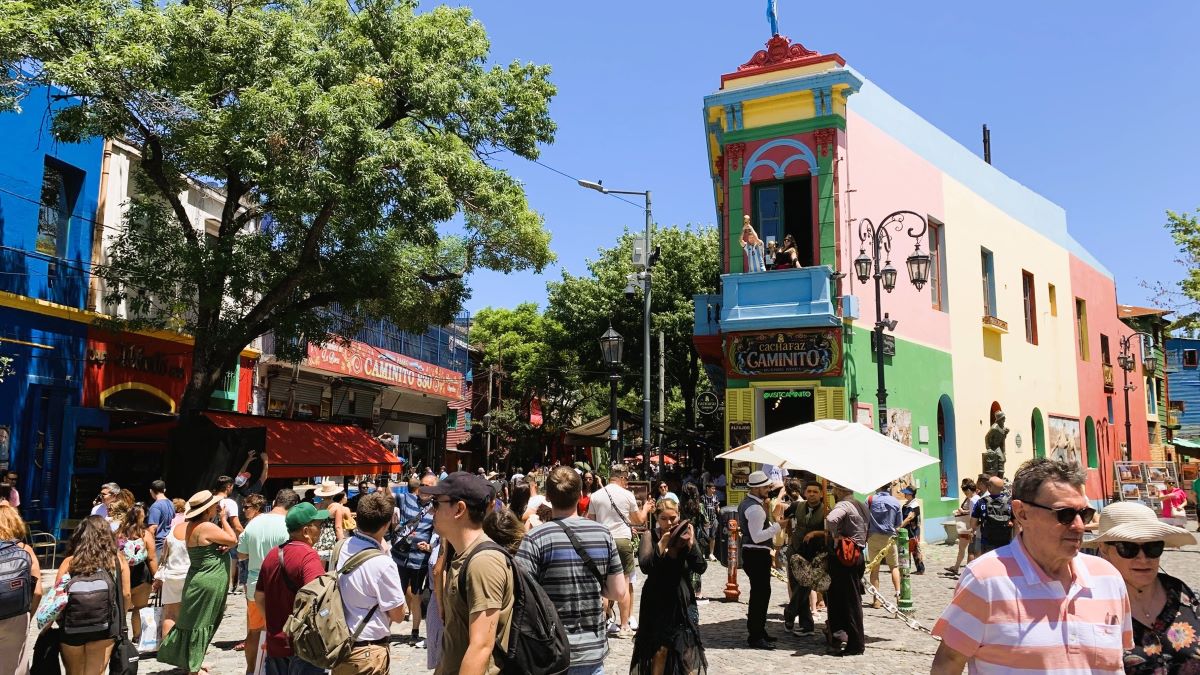
Before we jump into the 20 best things to do in Buenos Aires, here’s a little background to get you oriented.
Buenos Aires is the exciting capital of Argentina, and it’s full of energy, color, and charm. Known as the “Paris of South America,” this city blends old European style with Latin American passion. It’s a place where you can walk past grand old buildings, hear the sounds of tango music in the streets, and enjoy some of the best steak in the world.
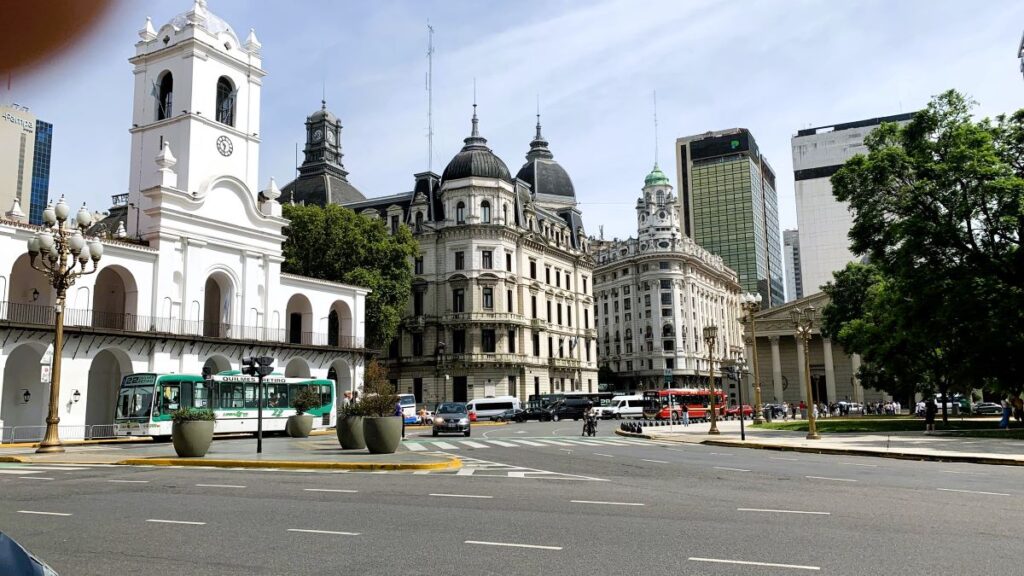
For a first-time visitor, Buenos Aires has something for everyone. You can explore lively neighborhoods like colorful La Boca, stylish Palermo, or historic San Telmo. There are parks to relax in, museums to wander through, and cafés on every corner. The people, called porteños, are friendly and full of pride for their culture.
My wife and I spent 10 days here in January/February 2025, and we fell in love with it. The vibe is captivating, and the people are full of charm.
Other Related Posts:
The first thing we did when we arrived was take a walking tour. I highly recommend it. You get to see all the main attractions and learn about their history and background, and your tour guide is the perfect person to provide recommendations to help you make the most of your trip.
We like to use Guru walking Tours. We’ve used them in almost every country we’ve been to and we’ve had wonderful experience with them. They work on tips. So you never have to make any payment when you make your booking. We’ve always found the tour guides informative and fun with a great sense of humour.
Our guide – Santiago- was awesome! He described Argentians this way – he said, “Argentinians are Italians, who speak Spanish, but think they are French“. 🙂
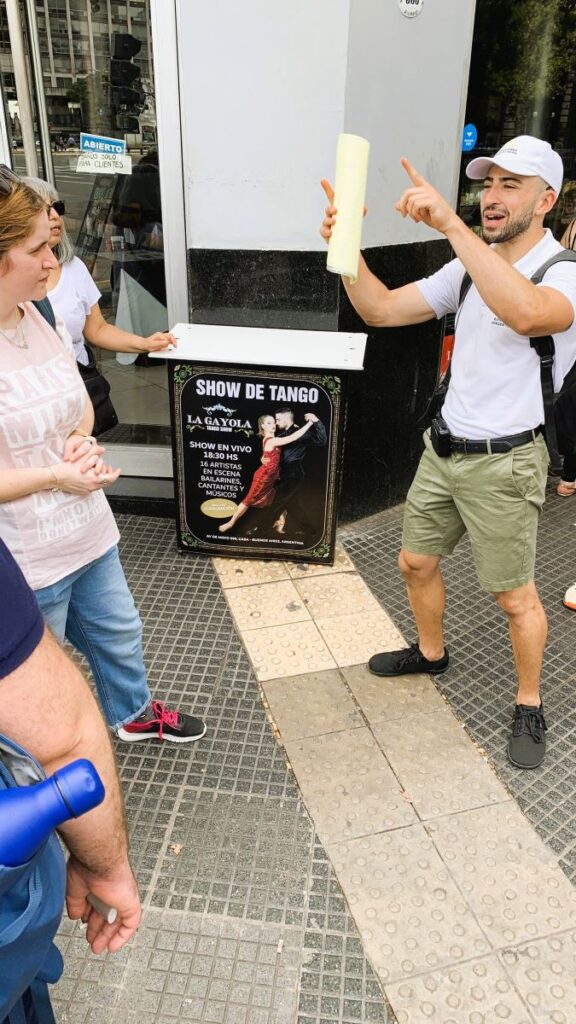
This guide to the 20 Best Things to Do in Buenos Aires highlights classic attractions and hidden gems, ensuring first-time visitors experience the best of Buenos Aires: its culture, food, history, and everyday life.
Marvel at Buenos Aires’ Iconic Landmarks
The historic center of Buenos Aires impresses with architectural grandeur. Traces of Argentina’s past are reflected in each of these landmarks; moments of independence, periods of artistic excellence, and waves of immigration that shaped daily life.
Casa Rosada at Plaza de Mayo (Pink Palace)
At the heart of Buenos Aires stands Casa Rosada, the famed presidential palace, or “Pink Palace”. Painted an instantly recognizable pink, it faces the city’s oldest square—Plaza de Mayo.
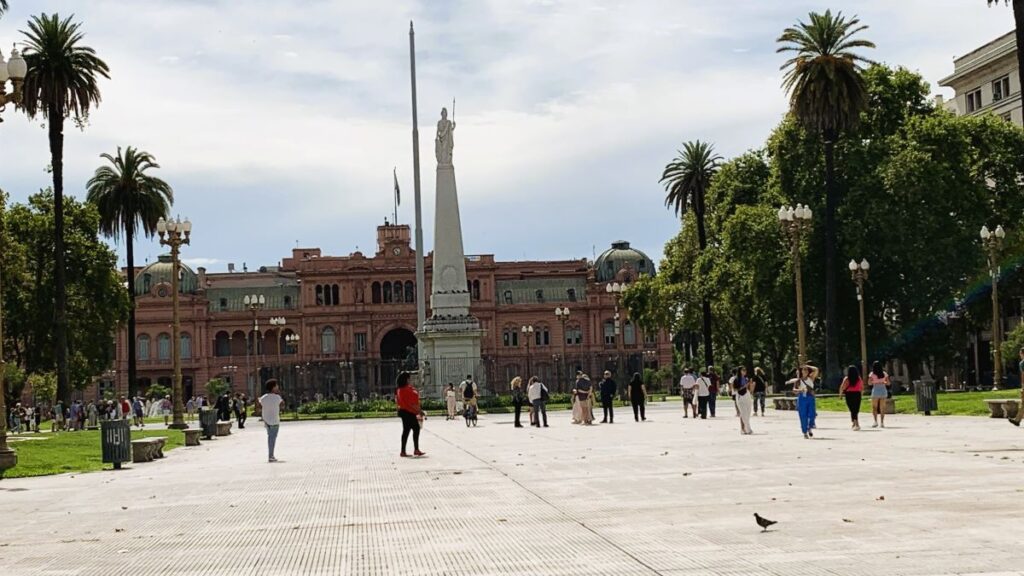
The Plaza de Mayo was the meeting place for our walking tour. There are several subte (metro stations) near here servicing different metro lines – Line A, Line D and Line E. It makes it very easy to get here. I suggest you start here as well. Many of the attractions are within easy walking distance from here.
The pink palace is the seat of Argentina’s executive branch. But it’s not just that. It is a powerful symbol of the nation’s turbulent political history. It’s a witness to protests, celebrations, and moments that shaped Argentina.
The balcony of Casa Rosada looks out onto the plaza, immortalized by Eva Perón’s historic addresses.
Plaza de Mayo has been the stage for public gatherings since colonial times. Surrounding the square, you’ll find the imposing Metropolitan Cathedral, City Hall, and reminders of Argentina’s independence movement.
Visiting the Casa Rosada is both easy and rewarding. While the exterior alone is worth a stop (especially for that perfect photo op in Plaza de Mayo), you can go even deeper with a free guided tour offered on weekends and public holidays.
These tours take you inside the grand interior, including the famed balcony, the Presidential Office, and various ceremonial rooms, all while sharing stories that shaped the country.
Free tours reveal rich interiors and political history, connecting the past with present-day events.
- Explore more about Casa Rosada at the city’s official tourism site.
- Learn about Plaza de Mayo’s historic monuments from the tourism website.
Metropolitan Cathedral
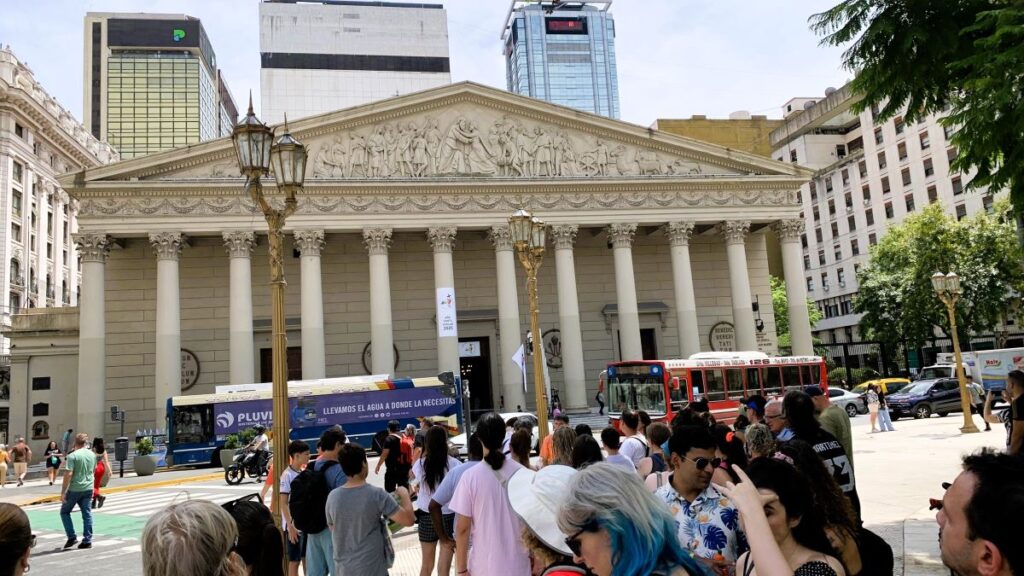
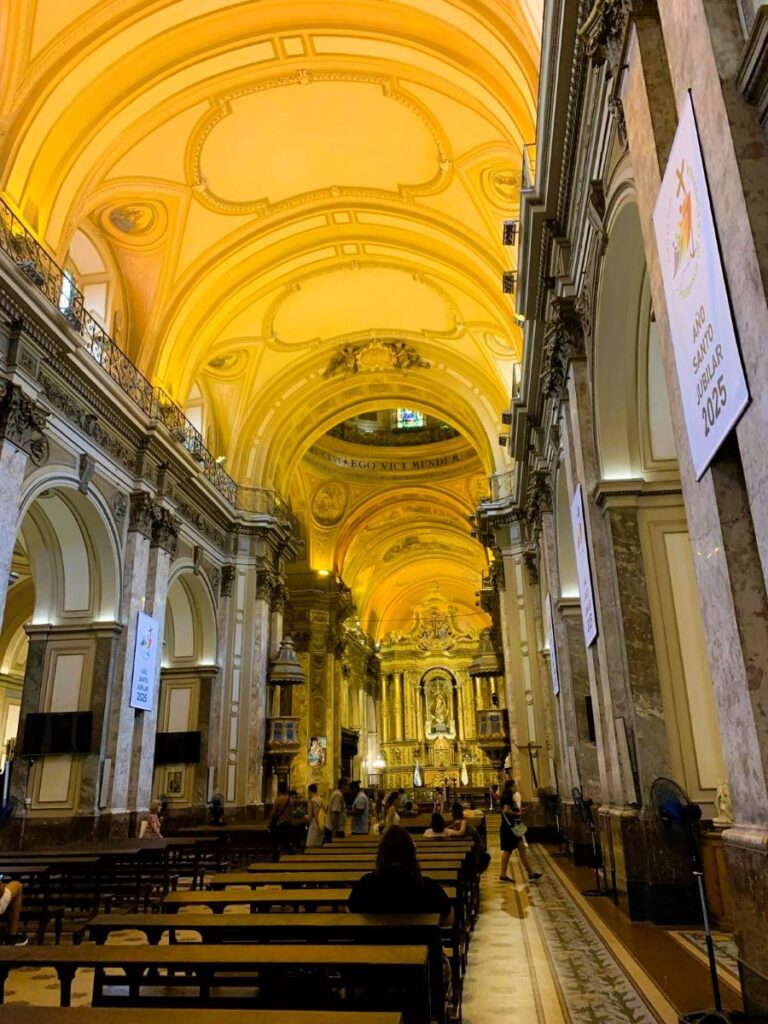
After admiring Casa Rosada walk over to the Metropolitan Cathedral of Buenos Aires at the edge of Plaza de Mayo. It might not look like your typical grand church at first glance—but don’t let its neoclassical façade fool you. Step inside, and you’ll find a treasure trove of Argentine history, art, and faith tucked within its ornate walls.
What makes this cathedral truly special is its unique blend of European elegance and national pride. Its soaring columns evoke a Roman temple, while the richly decorated interior is deeply Catholic Argentina.
But perhaps the most powerful reason to visit lies in one quiet corner of the cathedral: the mausoleum of General José de San Martín, the revered liberator of Argentina, Chile, and Peru. Guarded around the clock by soldiers in traditional uniform, it’s a moving tribute to one of South America’s greatest heroes.
Beyond its historical and spiritual significance, the cathedral is a peaceful escape from the city’s hustle and bustle.
Explore the Obelisco and Avenida 9 de Julio
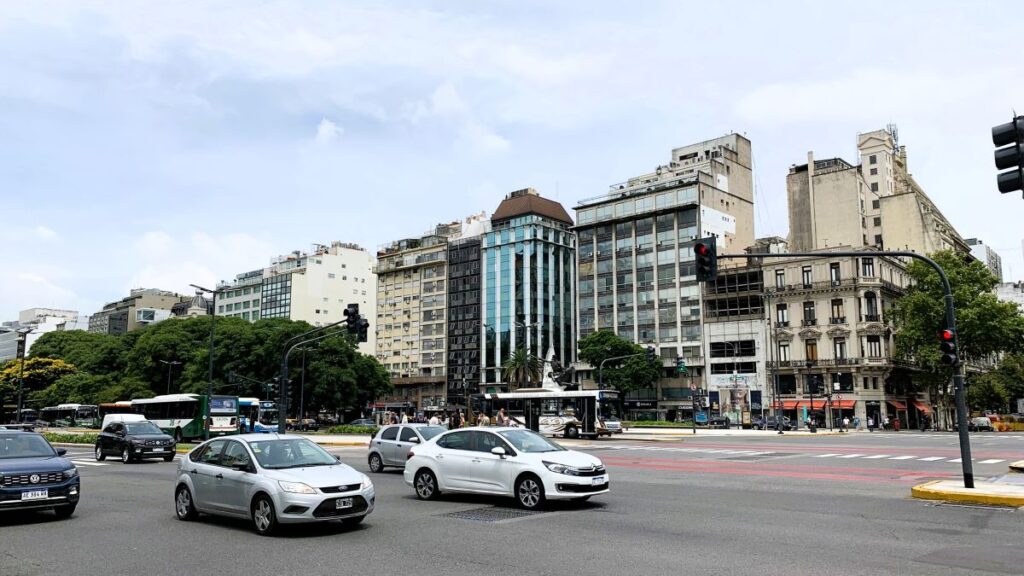
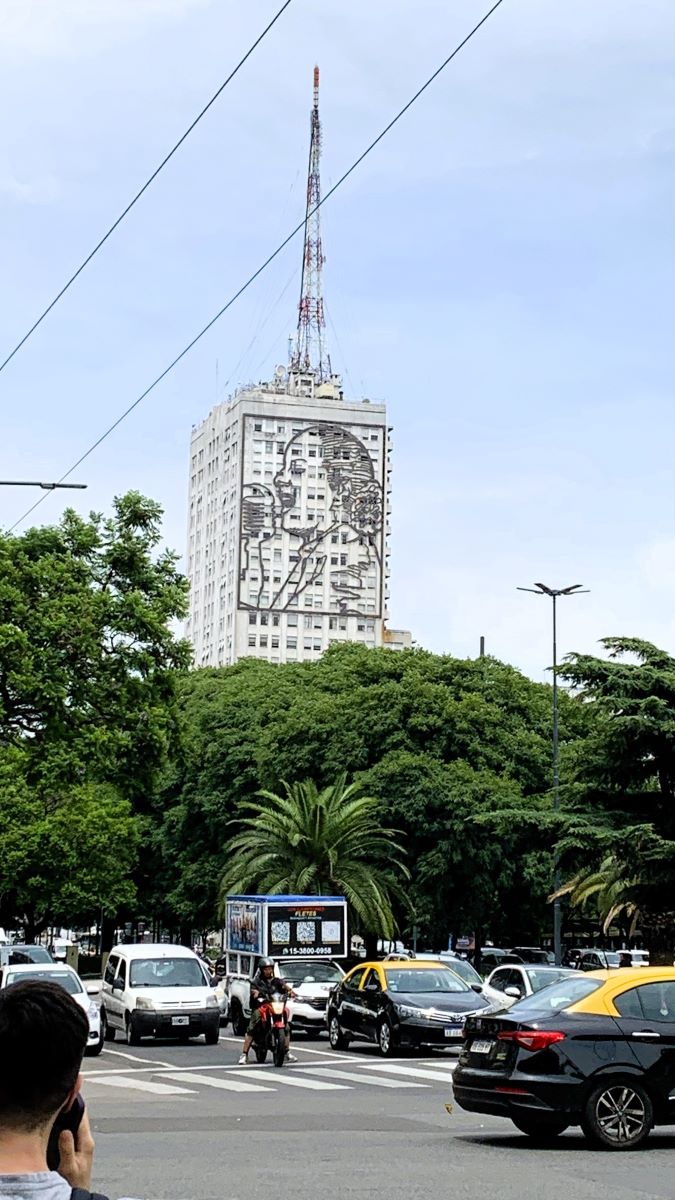
The Obelisco rises from the intersection of Avenida 9 de Julio and Corrientes, serving as the city’s most recognized feature. Built in 1936 for the 400th anniversary of Buenos Aires, this slender monument marks the spot where the national flag first flew in the city.
It’s the city’s ultimate meeting point, a stage for celebrations, protests, and spontaneous tango performances.
One of the most iconic stories tied to the Obelisco happened in 2005, when a group of activists managed to climb the structure and unfurl a giant pink condom over it, aiming to raise awareness for World AIDS Day. The stunt was both shocking and brilliant as it brought attention to the cause from around the world.
Named after Argentina’s Independence Day, July 9th, Avenida 9 de Julio is a grand statement in the heart of Buenos Aires. Widely considered the widest avenue in the world, this iconic boulevard slices through the Argentine capital like a river of movement, energy, and history. It stretches over 3 kilometers and boasts up to 14 lanes of traffic at its widest point.
But there’s more to Avenida 9 de Julio than its sheer size. Flanked by leafy trees and grand buildings, it offers a captivating snapshot of Buenos Aires’ spirit: bold, elegant, and full of life.
Visiting Avenida 9 de Julio is definitely one of the top 20 things to do in Buenos Aires.
- Find more about the significance of Avenida 9 de Julio.
- The official tourism site offers facts about this monument’s history and role in the city’s life.
Visit the Majestic Teatro Colón
Take a guided tour of Teatro Colón.
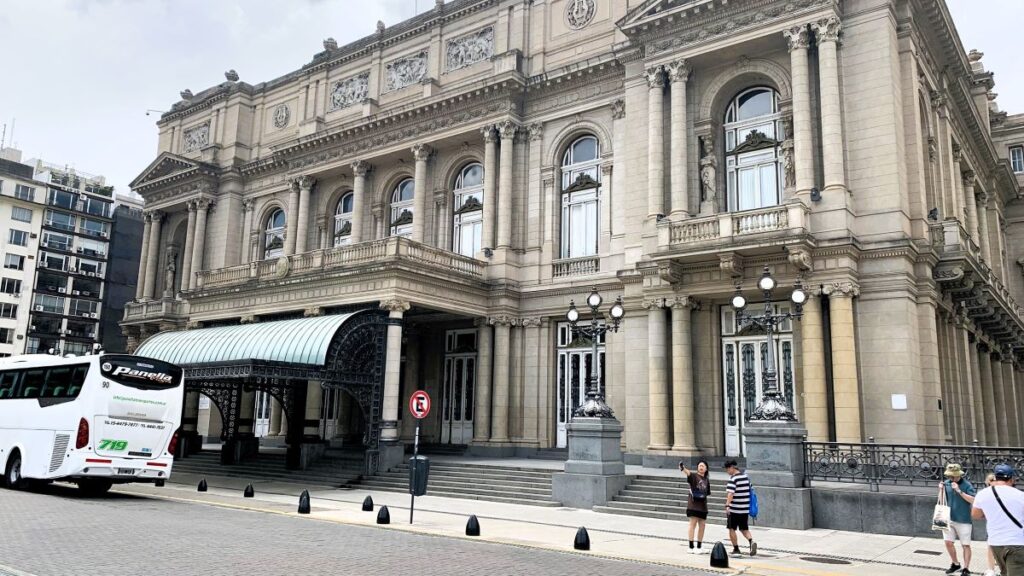
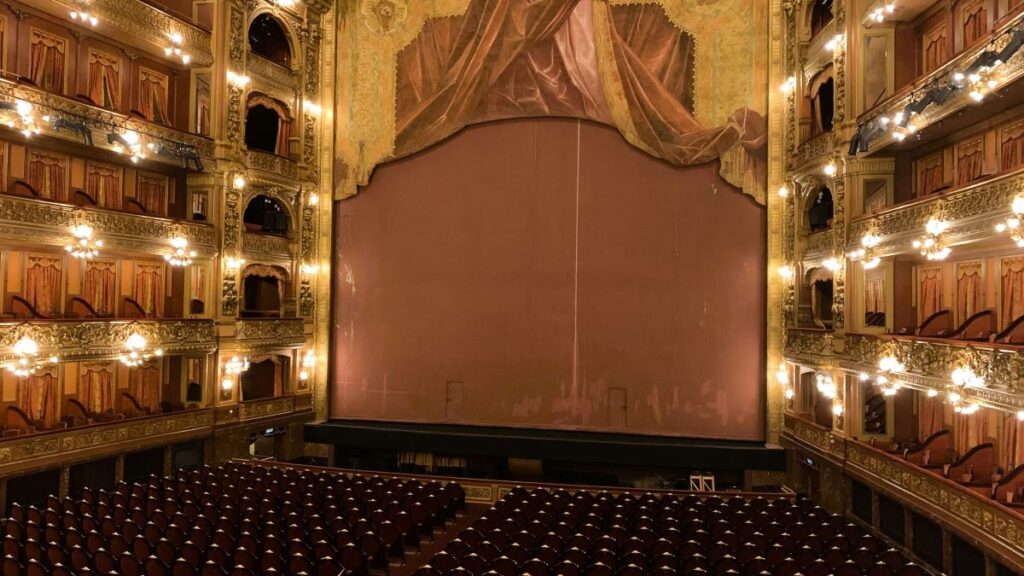
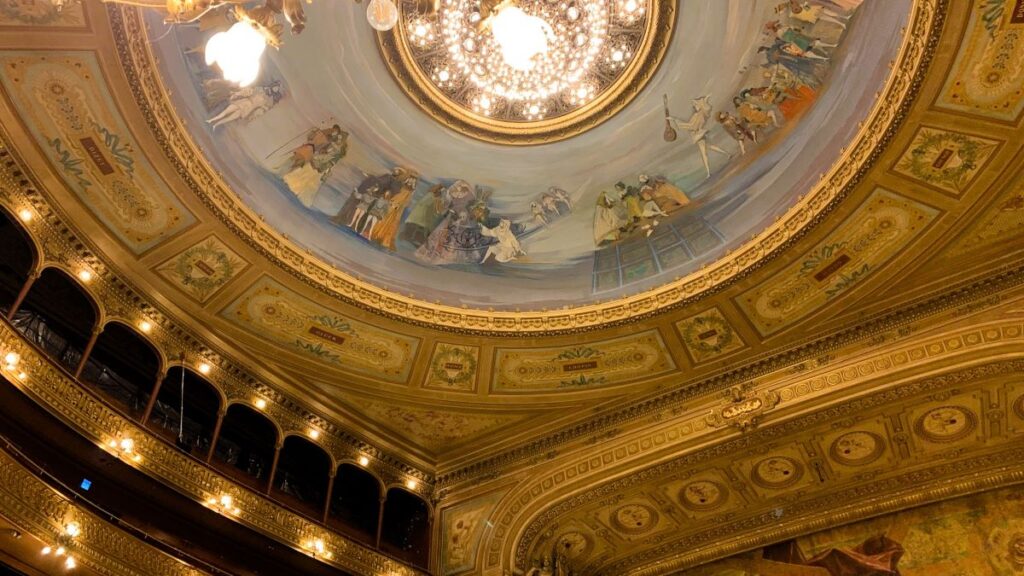
Few theaters in the world rival the prestige of Teatro Colón. We’ve been to the Vienna Opera House, Teatro alla Scala of Milan, and some other Opera Houses around the world. In my opinion Teatro Colóno is up there with the best of them. I list it as one of the top 20 things to do in Buenos Aires.
Opened in 1908, this grand opera house is praised for its near-perfect acoustics and elegant design. Gilded balconies and marble staircases transport visitors into a different era.
It’s a national treasure and a symbol of Argentina’s rich artistic soul. This majestic theater has hosted world-renowned performers from Luciano Pavarotti to Igor Stravinsky, and its architecture alone is worth the visit.
With its grand chandelier, plush red velvet seats, and impeccable acoustics, Teatro Colón has earned a spot among the finest concert halls in the world.
Guided tours give access to rehearsal rooms, dressing spaces, and the main performance hall. The richness of the décor and the aura of past performances linger even during the quietest moments.
Tours are offered daily from 10:00 AM to 4:45 PM, departing every 15 minutes. Each tour lasts about 50 minutes and is available in Spanish or English. Tickets can be purchased in advance on the official Teatro Colón website or at the theater’s box office.
General admission is typically around ARS 12,000 for international visitors (about USD 12–15, depending on the exchange rate), with discounts available for local residents, students, and seniors. Be sure to arrive a few minutes early, as tours often fill up—especially during weekends and peak tourist season.
- Learn more about the building on the Teatro Colón official website.
- Discover why it’s considered one of the world’s best at Teatro Colón Wikipedia.
Admire Palacio Barolo’s Architecture and Views
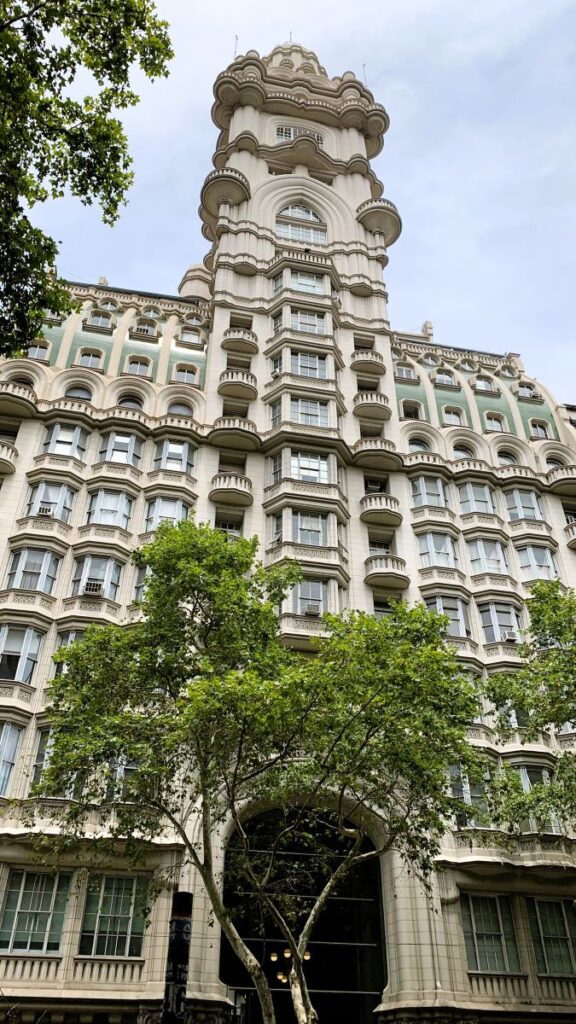
Rising from Avenida de Mayo, Palacio Barolo draws attention with its eclectic style and symbolic structure.
Inspired by Dante’s Divine Comedy, the building splits into three sections—hell, purgatory, and heaven—mirroring the journey in Dante’s epic poem. Since its opening in 1923, the Palacio has been a landmark of Buenos Aires’ ambition and creativity.
We didn’t go inside, but admired it from the outside. You’ll find intricate stonework and Gothic details on the exterior. I’ve read that the interior is also interesting. It blends old-world elegance with poetic references. At the top, a lighthouse crowns the structure, once the tallest point in South America.
Guided tours climb through each “layer” of the building, ending with panoramic rooftop views of the city’s grid and domes.
Neighborhoods of Buenos Aires: They Are Full of Character
One of the best things to do in Buenos Aires is to walk through the neighborhoods. We did that a lot. We walked everywhere. That’s the best way to get to know the city and its neighborhoods, and discover the hidden gems.
Each barrio has a story, from workers’ origins to artistic flourishes and leafy promenades.
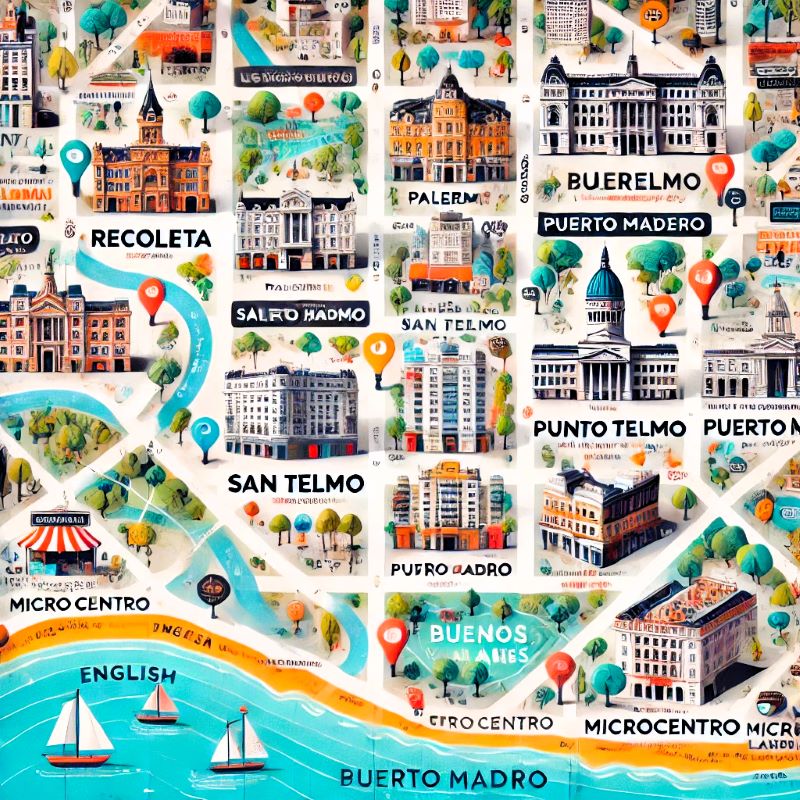
Wander the Colorful Streets of La Boca and Caminito
La Boca, with its bold colors and bustling energy, stands as one of the most recognizable neighborhoods in Buenos Aires. The houses here, known as conventillos, line the celebrated Caminito—a vivid lane remembered as the birthplace of tango.
Artists paint and sell their work along the sidewalks, while musicians and dancers fill the air with local melodies. Soccer fans might also note the famous Bombonera stadium, home to Boca Juniors. The area’s shipyard origins remain visible, reminding visitors of its working-class roots.
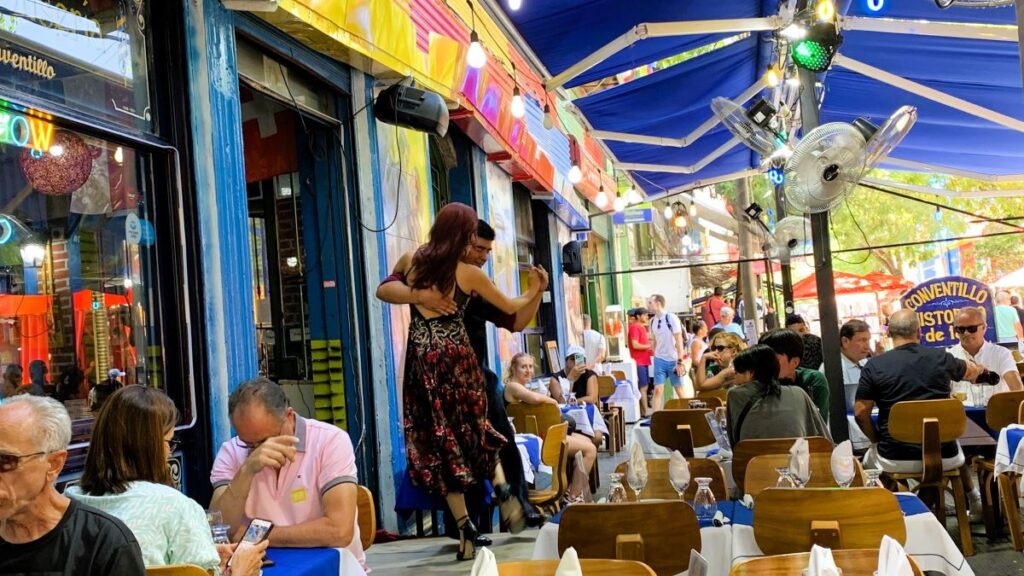
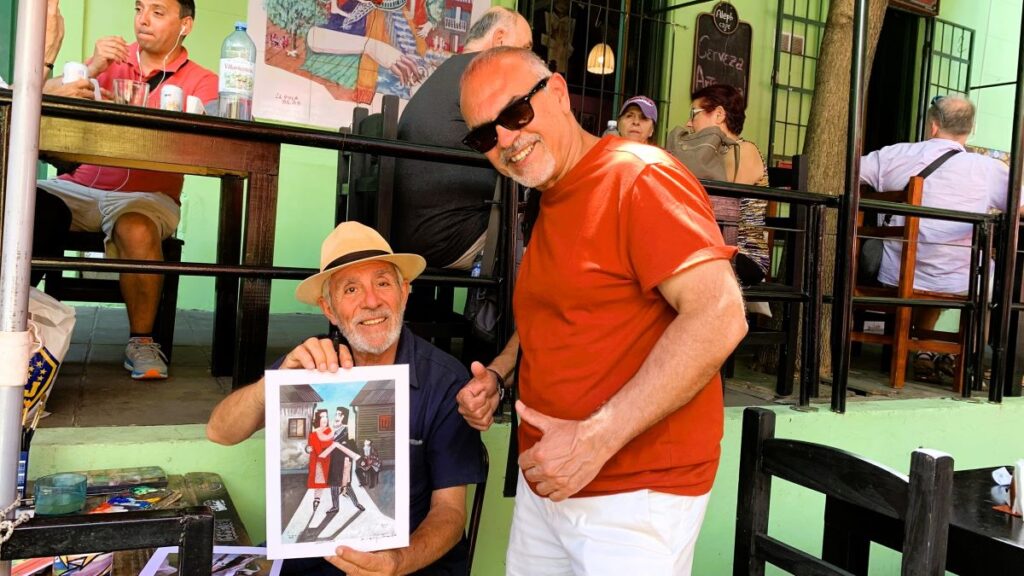
Key highlights:
- Painted tin houses along Caminito
- Live street tango performances
- Artisan markets and local artwork
- Historic soccer stadium atmosphere
Stroll Through Historic San Telmo and Its Markets
San Telmo gives a glimpse into Buenos Aires’ earliest days. Cobblestone streets and colonial-style buildings create a timeless atmosphere, especially around Plaza Dorrego.
Antique stores fill old storefronts, while the famous San Telmo Market draws crowds with its array of local goods. Sundays are pure magic. Feria de San Telmo, the famous street market, spills down Defensa Street with antiques, handmade crafts, and buskers who know how to draw a crowd. They have really nice leather goods at great prices. We bought a few things – 2 wallets (with work done on it) and a belt.
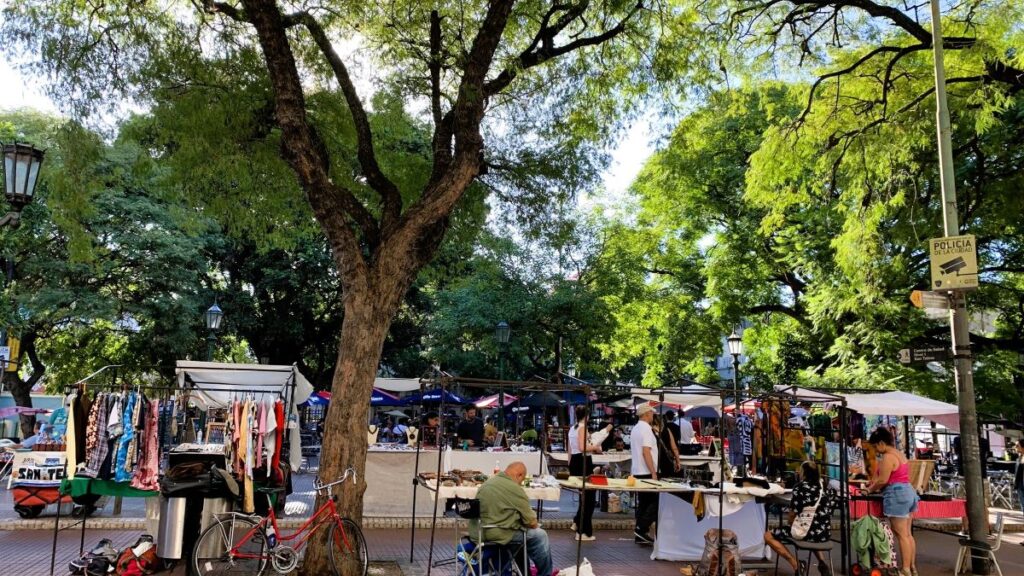
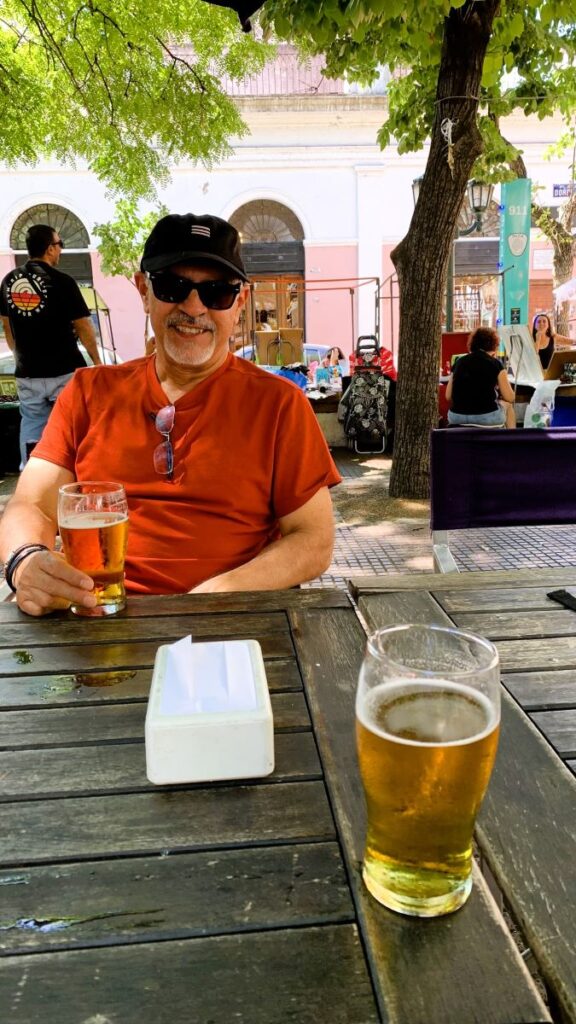
We spent hours here one day. There are cozy bodegones (traditional Argentine restaurants) serving hearty Argentine classics like milanesa and locro, and cool little eateries blending local flavors with modern twists.
Grab a table at a sidewalk café, or in the square, order a glass of Malbec or fernet with Coke, or the local beer, and watch the neighborhood hum around you. It’s a front-row seat to the real Buenos Aires. That’s what we did. We sat in the main square and watched the tango dancers dancing to live music. We had a great time! It’s a really cool place to spend a few hours.
San Telmo isn’t polished, and that’s what makes it unforgettable. It’s a little gritty, a little glamorous, and totally alive. When you think of the best things to do in Buenos Aires, this is one of them.
The neighborhood’s layered history—marked by waves of immigrants and changing fortunes—shows through its crumbling facades and lively plazas.
To learn about the market’s history and what to see, visit the San Telmo Market guide.
Key highlights:
- Original 19th-century iron market hall
- Frequent street art and murals
- Live music and weekend dance performances
- Rows of vintage shops and local coffee houses
Relax in Recoleta and Visit the Recoleta Cemetery
Recoleta stands out with tree-lined avenues, elegant cafes, and architecture inspired by Paris. It’s a lovely neighborhood. Here is where we stayed on our trip. It’s safe and beautiful.
The area is best known for the Recoleta Cemetery, a labyrinth of marble mausoleums that house many of Argentina’s most famous figures, including Eva Perón. Visitors walk quietly among rows of statues and tombs, noticing the detail in each monument.

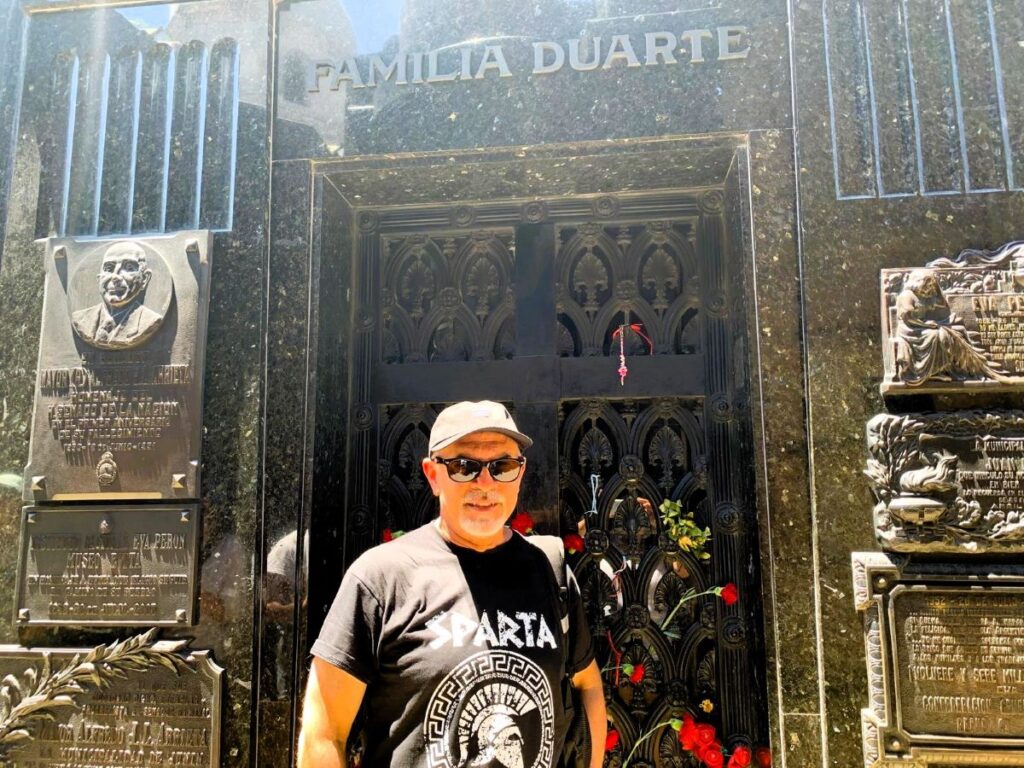
Outside the cemetery, parks and cultural centers offer space for rest and reflection. Art museums and bookstores add to the neighborhood’s refined atmosphere.
For more background and visiting information, check the official Recoleta Cemetery site.
Recoleta can be explored by:
- Touring the cemetery’s notable graves
- Enjoying an afternoon in Plaza Francia
- Visiting nearby art museums and craft fairs
- Sipping coffee in historic cafes
To learn more visit my post: Recoleta Cemetery in Buenos Aires: History, Highlights, and Visitor Tips
Soak Up the Vibe in Trendy Palermo
Palermo, the city’s largest barrio, attracts a young, creative crowd. Divided into smaller districts like Palermo Soho and Palermo Hollywood, it brings together independent shops, street art, and leafy plazas. Cafes spill onto the sidewalks, and boutique stores line the streets.
At night, the area transforms as restaurants and bars fill with locals and visitors alike. Green spaces such as the Botanical Garden and the sprawling Bosques de Palermo offer a calm retreat.
For an overview of the district’s variety and atmosphere, see the overview of Buenos Aires neighborhoods.
Palermo highlights:
- Unique designer boutiques and bookshops
- Bright murals and large-scale art installations
- Parks with walking paths and lakes
- Lively food scene day and night
Exploring these neighborhoods reveals everyday life in Buenos Aires and introduces hidden corners where the city’s character shines brightest.
Discover Buenos Aires’ Cultural and Artistic Side
Art and culture flourish everywhere in Buenos Aires. The city’s rich heritage shines through its dance halls, celebrated galleries, and breathtaking architecture.
Exploring its vibrant cultural life offers deep insight into local traditions. The following sections highlight essential experiences that are part of the best things to do in Buenos Aires.
Dance the Night Away at Buenos Aires’ Best Tango Shows
Tango is a symbol of Buenos Aires—it’s a powerful part of the city’s culture and history. You can’t come to Buenos Aires and not watch a tango show.
Born in the streets of Argentina in the late 1800s, tango is filled with passion, drama, and elegance. You can enjoy amazing tango shows all over Buenos Aires, where skilled dancers glide across the stage to live music.
To be honest we had a hard time deciding which tango show to go to. There are so many to choose from. We checked with the hotel staff, googled for suggestions, and talked to other people that we met in the hotel. One lady heard us talking to someone about it and came over to say that she had been to the best tango show just the night before. It was called Señor Tango. That was it. We decided to go for it too. We were not disappointed. It was an awesome performance. It was a big, broadway-style show with steak dinner and wine. We enjoyed it a lot. They even arrange the ride to and back from your hotel, which was very convenient. The total cost, including the show, steak dinner, wine, pick up and drop off was 150,000 pesos per person. This was for front seats. You have cheaper options – you can skip the dinner and pay less.

Some people prefer a more intimate and authentic setting. For that you must visit a social dance hall called milonga. Consider a Tango Tour.
Major venues each offer their own take on tango’s history and rhythms:
- Señor Tango (Barracas): This is a big, Broadway-style show with dramatic flair.
- El Querandí (Monserrat): This historic venue features an intimate show with live music and a narrative that traces the evolution of tango.
- El Viejo Almacen (San Telmo): Known for its old-fashioned charm, it presents classic tango performances in the San Telmo district.
- Café de los Angelitos (Balvanera): Here, guests enjoy lavish costumes and a vibrant stage, reflecting tango’s Golden Age.
- Rojo Tango (Puerto Madero): At the Faena Hotel in Puerto Madero transforms the dance into a modern spectacle with dramatic color and style.
- La Ventana (San Telmo): This San Telmo venue blends tango with folk music and regional traditions.
- Piazzolla Tango (Downtown): Set inside a restored theater, it pays tribute to Astor Piazzolla’s innovative approach.
For a more local experience, visit a milonga—a social dance hall. It reveals how tango lives on as a nightly tradition. Milongas welcome visitors to observe or even try the dance themselves, guided by passionate locals.
Experience World-Class Art at MALBA and Museo Nacional de Bellas Artes
Buenos Aires has world class art galleries and museums. If you’re an art lover you’ll find Buenos Aires to be a hub of creativity and inspiration. Even if you’re not and a big-time art lover you should still visit these galleries. We were blown away by their collection. The city’s premier art institutions house vast collections that reflect both Argentine and international talent.
- Museo de Arte Latinoamericano de Buenos Aires (MALBA) focuses on 20th- and 21st-century Latin American art, spotlighting figures like Frida Kahlo and Diego Rivera among many others. The collection bridges historic works and bold new voices.
- Museo Nacional de Bellas Artes offers a sweeping view of Western art, including pieces by Goya, Van Gogh, and local masters. The museum’s Recoleta location makes it an easy stop for visitors interested in Argentina’s artistic legacy.
To plan your visit or learn more, check out the best museums to visit in Buenos Aires.
Visit the Historic El Ateneo Grand Splendid Bookstore

This is an amazing bookstore! We had never seen anything like this. Housed in a former theater, El Ateneo Grand Splendid is considered one the most beautiful bookstores in the world.
It offers a unique setting to appreciate literature and architecture. Its grand domed ceiling, red stage curtains, and ornate balconies create an atmosphere unlike any other shop. Readers wander aisles of books where patrons once enjoyed plays and concerts.
Enjoy a cup of coffee, while soaking in this unique setting, on the former stage that has now been transformed into a café.
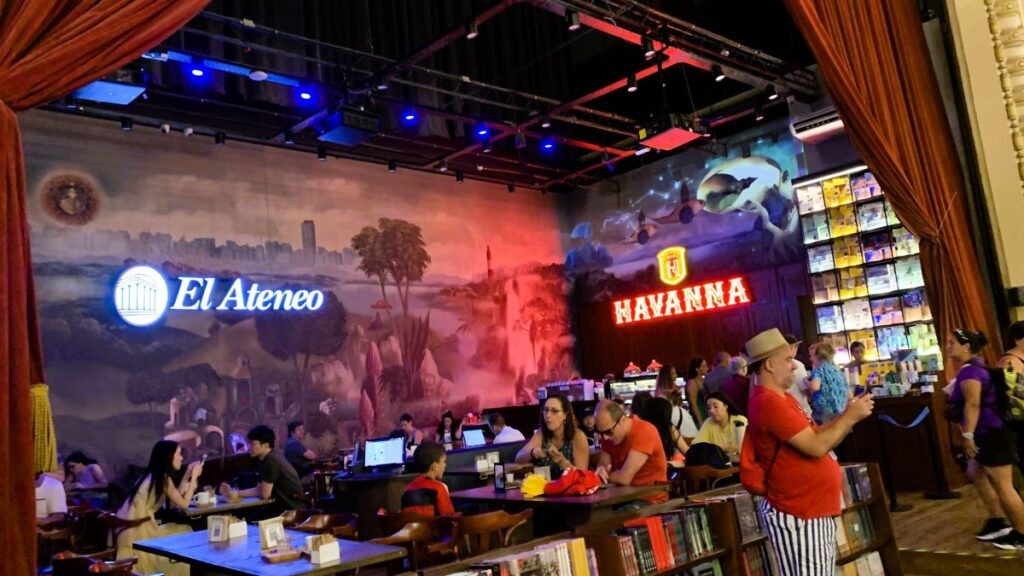
This unique bookstore needs to be on your list of the best things to do in Buenos Aires.
More information can be found on the El Ateneo Grand Splendid bookstore official page.
Enjoy the Cultural Offerings at Centro Cultural Kirchner
The Centro Cultural Kirchner (CCK) stands as one of South America’s largest cultural centers. Located in a restored post office building from the early 20th century, CCK spreads over nine floors and offers exhibitions, concerts, and stage productions. Its stunning concert halls and galleries make it a top choice for art, music, and theater lovers.
CCK’s calendar is filled with free events, from classical music recitals to avant-garde installations. The building itself is worth a visit, with soaring spaces and modern design woven into the original Beaux-Arts structure.
Visitors wanting to experience a range of local and international culture should explore CCK’s official offerings for current exhibits and events.
Taste Buenos Aires: Steakhouses, Cafés and More
Buenos Aires is a city known for its food culture. Sharing a meal or enjoying coffee here is a tradition.
From smoky steakhouses to grand coffee houses, exploring the city’s flavors stands out for anyone looking for real things to do in Buenos Aires.
Dine at Traditional Parrillas: The Ultimate Argentine Steakhouse Experience
Nothing says Buenos Aires like a night at the parrilla, the Argentine steakhouse. These restaurants bring together the customs of open-fire cooking and fine beef that has become Argentina’s identity.
The menu centers on grilled meats—thick ribeyes, juicy chorizo sausages, or a tender bife de chorizo served with chimichurri and fresh bread.
Famous parrillas like Don Julio in Palermo or La Brigada in San Telmo keep traditions alive with wood-fired grills and attentive service. Many steakhouses offer a warm, casual setting where families gather on weekends and friends hang out late into the night.
Popular sides include crispy papas fritas and classic mixed .. Ste akhouses are a main attraction for visitors, as each bite brings the city’s food heritage to life.
Here are some suggestions by the locals for the best parrillas in Buenos Aires:
- Salta el Fuego: traditional steakhouse. Great value daily menu at lunchtime.
- El Remanso: All you can eat parrilla with great prices, open only at night on weekdays.
- La Soñada: Humble setting but good meat, budget friendly and very local.
- Parrilla Cero5: Mid-range prices, great quality and friendly staff.
- El Ferroviario: Far from the centre but worth the trip for giant portions and authentic atmosphere. Book in advance.
- La Cabrera: More upscale option.


Sip Coffee in the City’s Iconic Cafés
Buenos Aires cafés are historic. Many date back over a century, filled with marble-topped tables, heavy oak bars, and framed mirrors that once reflected the faces of writers, politicians, and artists.
Places such as Café Tortoni, Las Violetas, and Café de los Angelitos are much more than coffee shops. Café Tortoni, opened in 1858, remains a hub for art and conversation. Las Violetas dazzles with stained-glass ceilings and ornate decor, serving fresh pastries and medialunas. Café de los Angelitos, famous since tango’s golden era, brings guests into the world of poets and musicians.
- Café Tortoni: Wooden interiors, murals, and live performances add to its charm.
- Las Violetas: Known for elaborate afternoon teas and striking belle époque design.
- Café de los Angelitos: A favorite for tango and music fans.
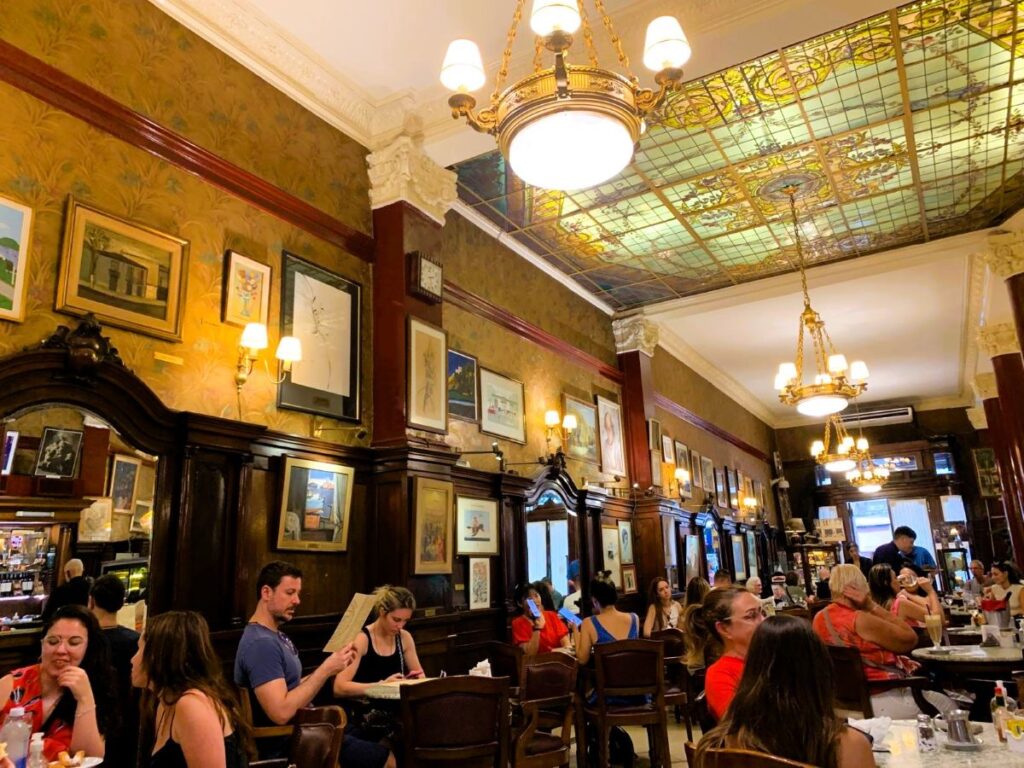
Sitting in these spaces lets you share a ritual that has defined social life in the city for generations. Whether for a quick cortado or a slow afternoon, these venues provide a glimpse into Buenos Aires’ everyday rhythms.
Sample Local Treats at the San Telmo Market
Just south of Buenos Aires’ city center, San Telmo is one of the oldest—and most soulful—neighborhoods in the city. Few markets represent Buenos Aires’ food scene quite like the San Telmo Market.
Founded in 1897, its cast-iron frame shelters stalls that offer a taste of old and new Argentina. Inside, you find everything from fresh produce and cured meats to empanadas, provoleta cheese, and pastelitos.
Walking the market’s lanes, you can try classic snacks like choripán—grilled sausage in a crusty baguette—or the sweet treat of dulce de leche-filled pastries.
Vendors often offer samples and stories along the way, blending commercial bustle with neighborhood warmth. Weekends see crowds of locals shopping, sipping espresso, or browsing for antiques among the scent of roasting meat and baked bread.
For travelers seeking down-to-earth things to do in Buenos Aires, this market captures the city’s range of flavors and its open spirit.
Enjoy Argentine Wine Tastings
Argentina stands among the world’s leading wine producers, with Malbec its most prized grape. In Buenos Aires, wine culture is accessible and thriving, offering visitors the chance to learn and taste in settings both traditional and modern.
Many steakhouses and dedicated wine bars present tastings of bottles from Mendoza, Patagonia, and beyond. These guided tastings introduce you to local varietals—Torrontés, Cabernet Sauvignon, and Bonarda—paired with cheeses and charcuterie. Some venues, like local vinotecas, mix education with informal enjoyment, inviting both experts and curious newcomers to share the experience.
Wine tasting is one of the most memorable and flavorful things to do in Buenos Aires for anyone interested in food and culture.
Nature Escapes and Active Adventures in Buenos Aires
Buenos Aires is well-known for its lively streets and grand architecture, but it also offers quiet natural spaces and outdoor adventures for visitors. Green parks, wild reserves, and nearby countryside offer chances to enjoy fresh air and see another side of the city.
For those searching for things to do in Buenos Aires beyond the usual city highlights, these natural retreats provide calm, beauty, and a connection to Argentina’s land and wildlife.
Stroll or Cycle Through Bosques de Palermo and El Rosedal
The Bosques de Palermo, found in the heart of the city, offer tree-lined paths, lakes, and gardens. Local families and visitors stroll, jog, or rent bicycles to explore these broad green spaces.
The air smells of wet grass and blooming flowers. El Rosedal, nestled within Bosques de Palermo, is known for its rose garden. More than 18,000 rose bushes create a colorful scene—especially in spring and early summer. Ornamental bridges, classical statues, and peaceful benches invite rest.
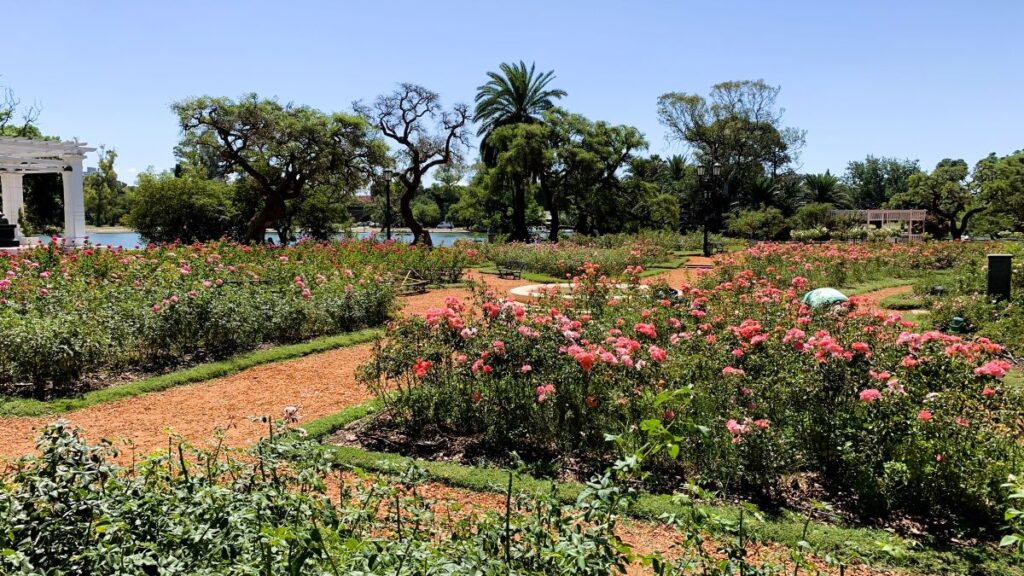
Cycling paths loop around the lakes. Paddle boats scatter across the water. Old trees give shade to picnickers and readers looking for peace. Whether walking or cycling, the Bosques give a calm break from city rush.
These parks are perfect for simple fun and healthy activity without leaving Buenos Aires.
Relax and Observe Wildlife in Reserva Ecológica Costanera Sur
Southeast of central Buenos Aires sits the Reserva Ecológica Costanera Sur. This nature reserve stretches along the Río de la Plata, creating a wetland area full of native plants and animals.
Paths take visitors through tall grasses and woods. Bird watchers spot herons, hawks, and dozens of other species, while butterflies and lizards share the trails.
The reserve is quiet and open—offering skyline views on one side and wild wetlands on the other. It is easy to spend an afternoon wandering and watching. Benches are spaced along the main paths, so visitors can pause to listen to birds or watch turtles bask. The reserve’s mix of city and nature shows how Buenos Aires balances urban life with environmental care.
For more information on visiting natural spaces, review nature and outdoor activities in Buenos Aires.
Take a Day Trip to Tigre and the Paraná Delta
North of Buenos Aires, the Tigre district and Paraná Delta offer a change from the city’s noise. Trains or buses carry visitors from the city to Tigre in under an hour. There, a network of rivers and narrow islands forms the Paraná Delta. Boats ferry guests along winding waterways past local homes raised on stilts, lush vegetation, and marinas busy with weekend sailors.
Tigre’s waterfront has traditional markets, museums, and riverside cafes. The delta is known for kayaking, rowing, or simply enjoying the slow pace on a local boat tour.
You may choose to visit the Puerto de Frutos market for regional crafts and fresh produce. Spend a day here to experience a slower, river-centered way of life—far removed from city bustle.
For practical tour ideas, browse the options at Top Buenos Aires Outdoor Activities.
Experience an Argentine Estancia Day
Traveling just outside Buenos Aires brings visitors to the pampas—flat grasslands that have long supported ranches known as estancias. Many estancias welcome day visitors for a taste of rural life.
Activities often include horseback riding, traditional asado lunches cooked over open fire, and demonstrations of gaucho skills. The experience offers insight into Argentina’s rural heritage and values of hospitality.
The grounds of a typical estancia provide gardens, shade trees, and wide fields. Visitors can join rides, walk the land, or sit for mate—a classic Argentine tea.
Gauchos, with their distinct outfits and horsemanship, share the region’s history and customs. An estancia visit rounds out a Buenos Aires trip with both countryside scenery and a window into the traditions that shaped Argentina.
For more ideas on getting out of the city and into nature, the city guide on Buenos Aires surroundings provides helpful details.
These experiences show that the list of things to do in Buenos Aires includes rich opportunities to enjoy the outdoors and learn about Argentine traditions beyond city streets.
Navigate the City: Public Transportation in Buenos Aires
Getting around Buenos Aires is very easy. First of all it is a very walkable city. We walked everywhere. But their public transport system is excellent too.
The public transport system there is among the largest in South America. It blends old routes with modern updates, touching almost every part of town.
For any visitor making a list of things to do in Buenos Aires, understanding the buses and metro will greatly help to explore the city’s daily life and hidden corners.
Buses: The Lifeblood of the City
The local bus system, known as “colectivos,” is both colorful and extensive. Each bus route is numbered, covers specific parts of the city, and often runs 24 hours a day. Buses are a top choice for locals and regular visitors.
What we found helpful was that the addresses are very easy to spot from the bus. For example, if you know that you have to get off at 1812 Avenida Corrientes, you watch for the street sign for Avenida Corrientes when the bus turns onto it. Then you look for the numbers from the bus. They are clearly marked on the walls and easily seen from the bus. You’ll know exactly which bus stop you need to get off at. It’s very convenient.
- Buenos Aires’ buses connect all major neighborhoods.
- Routes are listed on signs and easy to check online or via local transport apps.
- Payment uses the SUBE card, a reloadable fare system that works across most transit modes.
You need cash to buy the SUBE card. We bought ours at a metro (or subway – same thing) station. The staff working at the metro stations is generally very friendly and helpful. We never had any problems.
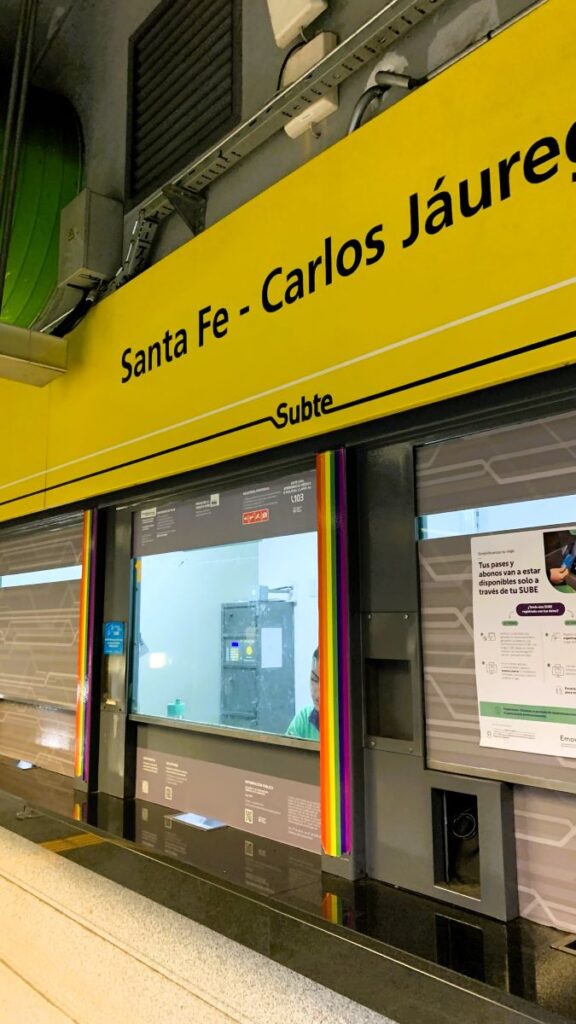


Bus stops can be busy at rush hour, but the experience provides a firsthand look at city life—shopkeepers, musicians, students, and workers travel side by side.
For an overview of all public transport modes, the official city guide on getting around Buenos Aires is clear and helpful.
The Subte: Fast Access to Key Sites
The Buenos Aires subway system, or “Subte,” is a fast option for medium or long trips. Opened in 1913, this subway is the oldest in Latin America and has played a role in shaping how people move across the city.
- The Subte has six main lines, each named with a letter (A, B, C, D, E, and H).
- It connects landmarks like Plaza de Mayo, the Obelisco, and many major avenues.
- Trains run every few minutes during peak times, with stations marked clearly above ground.
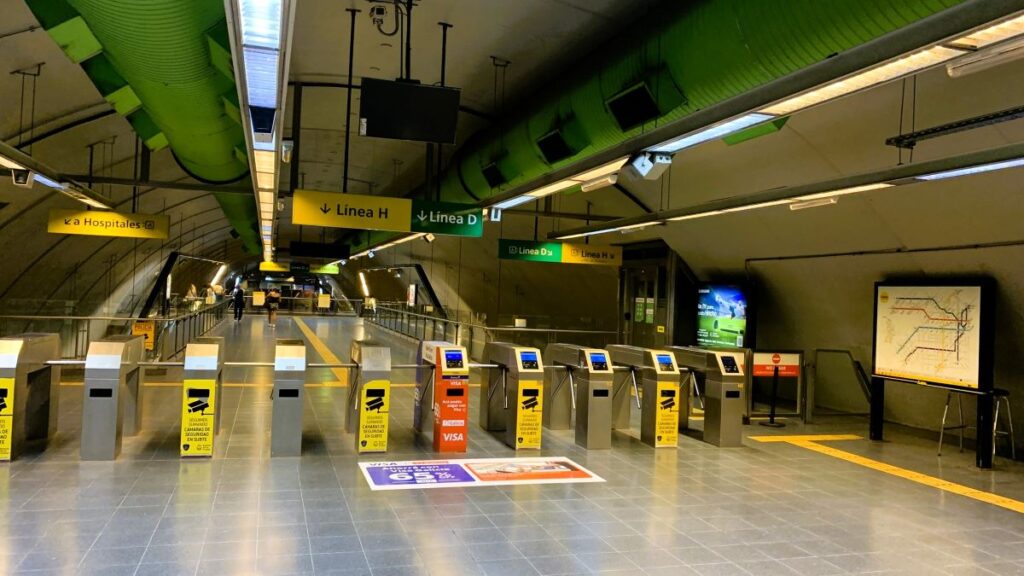
Tickets are paid using the SUBE card, and station maps show points of interest nearby. For newcomers, the Subte is a quick way to reach destinations on any list of things to do in Buenos Aires. Clean, direct, and often decorated with local art, the subway also reflects the city’s history and growth.
Learn more practical details with this Buenos Aires public transport guide.
Trains and Beyond: Reaching the Suburbs
Trains in Buenos Aires extend the city’s reach into nearby districts and suburbs. Main train stations like Retiro and Constitución serve as gateways for regional travel.
- Trains are essential if you plan to visit areas outside the city center, including Tigre and the northern suburbs.
- Schedules run from early morning to late evening, with frequent service on most lines.
- These trains also use the SUBE card, keeping payment consistent.
The trains reflect the broader layout and diversity of Buenos Aires. Travelers can see how residential and commercial zones span out from the city’s core. Taking a train also creates a direct link to day trips, like visiting Tigre and the Paraná Delta—both popular choices for those seeking different things to do in Buenos Aires.
Taxis, Ride-Sharing, and Cycling Lanes
While public transit covers most of the city, taxis are a common option for late-night trips or routes not reached by bus or train. All taxis are black and yellow, metered, and usually easy to flag down.
Ride-sharing apps are also active in Buenos Aires, providing another reliable way to move about. They have Uber in Buenos Aires. We used Uber there a few times. We took the Uber from the airport to our hotel in Recoleta. We used it to go the airport as well. And once or twice more.
For those who wish to explore by bike, Buenos Aires has built a growing network of dedicated cycling lanes. EcoBici, the city’s bike-share program, allows residents and visitors to cycle short distances for free or a small fee.
- Nearly every main avenue has a marked bike path.
- Bike-sharing stations are found in central areas and parks.
This mix of bike, bus, subway, and taxi rides provides flexibility while touring Buenos Aires. Planning routes and travel times is simple using public transportation maps and city guides. The experience of riding alongside locals—from the packed buses to the peaceful cycle paths—offers insight not just into city movement, but everyday life itself.
For more on planning your routes, this practical transportation survival guide is a helpful resource.
Currency Exchange
The currency in Buenos Aires is Argentine peso. You can change your currency right at the airport when you arrive. There’s a Banco Nacion located to the right side as you come out of customs. Just ask anyone. It’s a bit hidden away so won’t see it. Change your money there. It’s easy and the exchange rate is good.
There is also an informal market, sometimes called the “blue dollar,” where exchange rates are better but comes with legal and safety risks. If you’re curious about these local quirks, check this recent Reddit thread: Changing money in Argentina for dummies.
Conclusion
Exploring these top 20 things to do in Buenos Aires gives first-time visitors a true sense of the city’s spirit. Walking its historic streets, sampling classic foods, and witnessing local traditions reveal how culture and history shape daily life here. Whether pausing in a quiet park or taking in a night of tango, each experience adds another layer to understanding this city.
By moving between famous landmarks, welcoming neighborhoods, and hidden gems, you connect with the energy and community of Buenos Aires. These activities show how the past and present blend, making every visit memorable.
Thank you for joining me on this journey—share your favorite finds or stories from Buenos Aires to inspire future travelers.
Recent Posts:
-
Lake Bled Day Trip: The Perfect First-Time Adventure from Ljubljana
Welcome! If you’re spending time in Ljubljana and want to experience Slovenia’s most magical landscapes, a Lake Bled day trip from Ljubljana is an easy choice. With its glacial blue water, Lake Bled Island at its center, and Bled Castle perched high on the cliffs, this spot looks straight out of a fairytale—no need for…
-
Best Things to Do in Ljubljana, Slovenia (First-Time Visitor’s Guide)
Welcome! Thank you for visiting my blog about the best things to do in Ljubljana! In this guide I’ll share my own favorite spots and handy tips, best places to eat and some local insights you might not find elsewhere. Ljubljana, the charming capital of Slovenia, is stunning! The architecture is breathtaking! I promise you,…
-
Best Tango Shows in Buenos Aires: My Guide for First-Time Visitors
Buenos Aires is the birthplace of tango – raw, passionate, and unforgettable! But if it’s your first time in the city, choosing the right tango show can feel overwhelming. Do you go for the glamorous, cabaret-style performance with a gourmet dinner? Or do you slip into a smaller, historic venue where tango feels more like…
-
Recoleta Cemetery in Buenos Aires: History, Highlights, and Visitor Tips for 2025
Welcome to Recoleta Cemetery! “If you’re visiting Buenos Aires, this is a place you should see at least once. You’ll leave with photos, stories, and a deeper understanding of Argentina’s history.” Related Posts: Introduction: Why Visit Recoleta Cemetery? Recoleta Cemetery in Buenos Aires is not your typical graveyard.It’s more like an open-air museum filled with…
-
Tokyo vs Osaka: Your Guide To Understanding The Difference Between The Two Most Popular Cities in Japan [2025]
So the question is, Tokyo or Osaka which is better? Do you want to pick between the two? It can feel like it’s hard to decide, especially if it’s your first trip to Japan. We’ve been to both. We loved them both. We spent more days in Osaka than we did in Tokyo, and did…
-
The Ultimate 5-Day Itinerary in Tokyo: A Fun and Easy Guide for First-Time Visitors
5 Day Itinerary in Tokyo – A City of Contrasts and Wonders I’ve created this 5 day itinerary in Tokyo to help you get the most out of your time here. It’s based on my own experience in this incredible city. Tokyo is one of the most exciting cities in the world. It’s a place…




